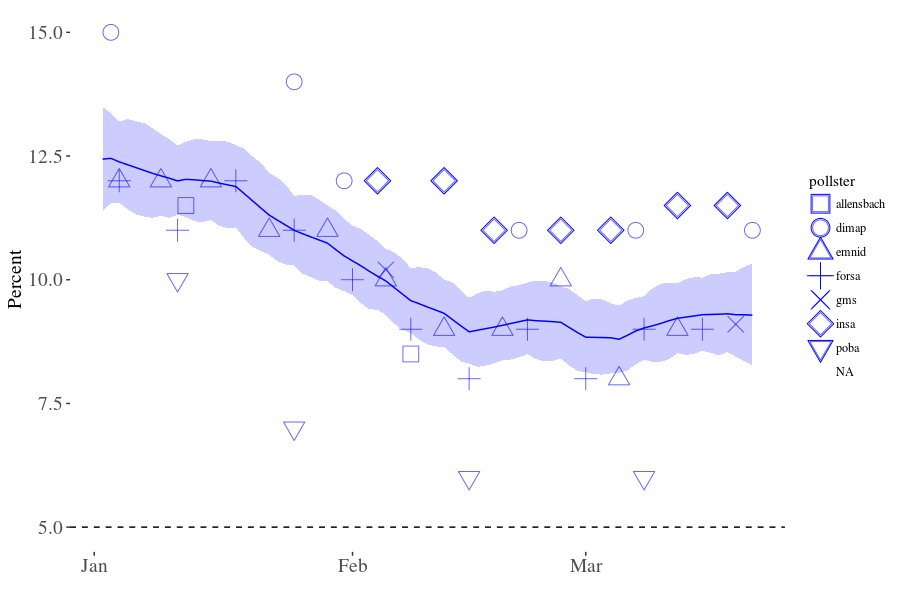The other day, someone on twitter suggested that the polls on the upper margins of my latest model-based estimates of AfD support were conducted by the “notoriously AfD-friendly INSA company”.
https://twitter.com/freifrauvonitze/status/845565084290158593
This view is not uncommon in Germany. INSA, who do polling for Germany’s premier tabloid Bild, want to prop up support for the AfD via a band waggon effect, because there is an alleged business and ideological link between their CEO and the AfD’s notorious Thuringia chapter (in German) – or so the story goes. A more innocent explanation is that INSA polls are based on internet access panels, and that the AfD is probably the most internet-savy party in Germany and hence overly popular with heavy users.
But is there any evidence of overreporting? As you can see here, INSA’s average estimate of AfD support is just one percentage point above the grand mean of all measurements – not such a huge difference. Also, they have only contributed seven polls to the total pool of 43 major polls whose results have been published since January.
| Pollster | n | AfD % (average) |
|---|---|---|
| Allensbach | 2 | 10 |
| Dimamp | 6 | 12 |
| Emnid | 11 | 10 |
| Forsa | 11 | 10 |
| GMS | 2 | 10 |
| INSA | 7 | 11 |
| Poba | 4 | 7 |
| All | 43 | 10 |
And perhaps these polls were conducted earlier in the year, before the model suggested that the AfD’s support fell by a couple of points? But no, this is not the case. INSA polling goes back until the first week of February. (In fact, there are even some INSA polls from January, which are not in the database because of a glitch in the script that I use to pull the data from the interwebs.) More importantly, each and every of the seven INSA polls is well above the credible interval around the model-based estimate:
So yes, INSA’s readings of AfD support are clearly unusually positive. But so are the Dimap polls, whereas FGW (Poba) are taking a distinctly bearish view.
Avid readers will remember that the model tries to account for party-specific house effects, under the overly optimistic assumption that these sum to zero across all firms. Given the small overall number of polls, and given that Allensbach and GMS have only published two polls each so far, I wouldn’t trust these estimates too far, but just for fun I’ve pulled them out of the mountain of simulated draws. According to the model, INSA overreports AfD support by 2 points (CI 1.5-2.6), Dimap by 1.8 points (CI 1.1-2.5), whereas FGW underreports AfD support by 2.5 points (CI -3.2-1.8). It will be interesting to see how the numbers develop over the coming months, and whether these estimates will square with the actual result. For the time being, take them with an appropriately large dose of salt.
Discover more from kai arzheimer
Subscribe to get the latest posts sent to your email.



Do we observe this in the Polls? I’ve found an old blog-post by @kai_arzheimer that provides some tentative evidenc… https://t.co/Zo91tTez5d
RT @kai_arzheimer: From the vault: Is INSA overreporting support for the AfD? https://t.co/DgCeWDfGnB
RT @kai_arzheimer: Is #INSA overreporting support for the #AfD? https://t.co/f8GhRtB2VT
RT @kai_arzheimer: Is #INSA overreporting support for the #AfD? https://t.co/f8GhRtB2VT
Glad that’s settled: Is #INSA overreporting support for the #AfD? https://t.co/kNBKR8KE8o via @kai_arzheimer
Mal lesen, liebe #afd ‘ler https://t.co/eEeg4OPAjP